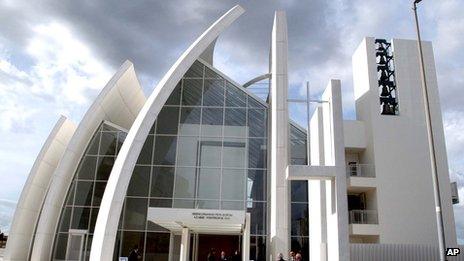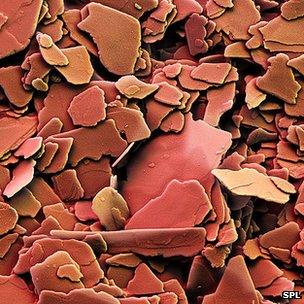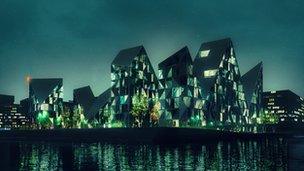'Smog-eating' material breaking into the big time
- Published

The Jubilee Church in Rome has titanium dioxide in its concrete "sails"
What material can you find in toothpaste, sunscreen, solar cells, on the baseline at Wimbledon, in a Roman church, and along a tunnel in Brussels?
Full marks if you guessed titanium dioxide, a nearly ubiquitous but wholly unsung material.
Its brilliant white has made it a staple in pigments - hence Wimbledon - but its eco-credentials are still coming to the fore.
Titanium dioxide does a couple of clever tricks that mean we may well be seeing a lot of it in the future: it's self-cleaning, and it breaks down pollutants in the air.
And the fact that thin films of it are clear is the reason that a number of manufacturers use it in glass applications such as skylights.
Paving the way
The self-cleaning aspect comes about because one processed form of titanium dioxide is what is called superhydrophilic - literally, "water-loving", which means that when water hits a dirty titanium dioxide surface, that surface will draw in a whisper-thin sheet of water across its whole surface, displacing grime that then washes neatly away.

Tiny loose flakes of titanium dioxide are used in cosmetics, toothpaste and sunscreen
But its second trick of removing pollutants is what has made it an increasingly popular choice for environmentally-minded building projects.
A bit of the ultraviolet light in sunlight frees up electrons from the material, creating "free radicals" that actively break down pollutants including so-called NOx gases (molecules of varying proportions of nitrogen and oxygen) or VOCs (volatile organic compounds).
A number of pilot projects around the world have seen the material used in, for example, concrete - hence the Jubilee Church in Rome. In Japan, Mitsubishi markets a brand of titanium dioxide-treated paving stones and Toto makes coated ceramic tiles.
The material hit the news again this week when the aluminium firm Alcoa announced its new product Ecoclean, a titanium dioxide coating on aluminium panels for cladding buildings.
The firm claims that 1,000 square metres of the coated panels eat up the equivalent NOx output of four cars.
"What we see, especially in Europe, is more and more legislation... about the air quality in cities, and I think that Ecoclean is a product that can really help mitigate the effects of emitters such as cars by its air-cleansing characteristics," Alcoa spokesman Jasper Van Zon told BBC News.
Ecology of scale
The fact that such a large manufacturer has joined the ranks could mean that the real-world use of the material can finally be assessed on a large scale, says Anne Beeldens of the Catholic University Leuven in Belgium.
Dr Beeldens has been working with colleagues for years to establish, with rigorous experiments, the full scope of titanium dioxide's effects in a built environment.
"We were really sceptical when we started with this, but it really works on the extraction of pollutants out of the air," she told BBC News.
"The problem is that you have so many parameters that it's sometimes hard to prove it. We got some promising results in the lab, but it was still in the lab; I think now it's all shifting to real applications."

"The Iceberg" building project in Denmark will incorporate Alcoa's titanium dioxide-coated panels
Dr Beeldens is involved with the European project Photopaq, external, which has among other experiments coated the interior of the Leopold II tunnel in Brussels, carrying out detailed measurements of the before-and-after effects over the course of two weeks.
In London's borough of Camden, a two-year trial of titanium dioxide-containing paint by a firm called Cristal showed significant reductions in pollutants - up to 65% - a short distance from the wall on which the paint was applied.
However, larger-scale trials will be needed to establish that titanium dioxide's convenient self-cleaning nature really can make an environmental difference in a real, open urban scenario.
And while the propensity of titanium dioxide to break down NOx and VOCs is well established, the full circle of chemistry that takes place is not entirely known.
"We will see from those results if any extra pollutant is formed by the reaction; you have to look not only at the reduction of the pollutants, but also to see if nothing more harmful is produced," she explained.
Laboratory experiments have shown, for example, that the breakdown of NOx chemicals can result in the creation of other pollutants such as nitrous acid, external or ozone, external. But Dr Beeldens said that real-world tests in Japan had not shown significant production of the chemicals.
The data from the tunnel test will help settle the question. And as large building projects make use of titanium dioxide-coated products, such as "The Iceberg" in Aarhus, Denmark, further large-scale experiments can be carried out.
Dr Beeldens said: "When I look at it in the last year, a lot of projects are starting where there's a link between application of the material and real air measurements, and I think once that link is really made, then it will start to be used all over the place."